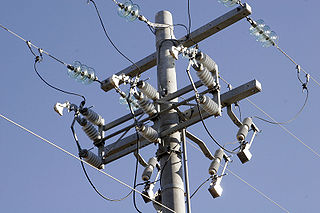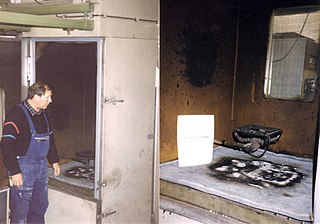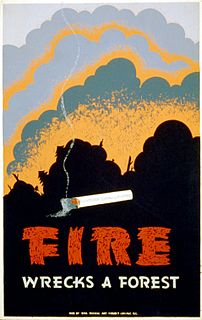
A firewall is a fire-resistant barrier used to prevent the spread of fire for a prescribed period of time. Firewalls are built between or through buildings, structures, electrical substation transformers, or within an aircraft or vehicle.

Pyrotechnics is the science of using materials capable of undergoing self-contained and self-sustained exothermic chemical reactions for the production of heat, light, gas, smoke and/or sound. Its etymology stems from the Greek words pyro ("fire") and tekhnikos. Pyrotechnics include not only the manufacture of fireworks but items such as safety matches, oxygen candles, explosive bolts and fasteners, components of the automotive airbag and gas pressure blasting in mining, quarrying and demolition.

The National Electrical Code (NEC), or NFPA 70, is a regionally adoptable standard for the safe installation of electrical wiring and equipment in the United States. It is part of the National Fire Codes series published by the National Fire Protection Association (NFPA), a private trade association. Despite the use of the term "national", it is not a federal law. It is typically adopted by states and municipalities in an effort to standardize their enforcement of safe electrical practices. In some cases, the NEC is amended, altered and may even be rejected in lieu of regional regulations as voted on by local governing bodies.
The National Fire Protection Association (NFPA) is a United States trade association, albeit with some international members, that creates and maintains private, copyrighted standards and codes for usage and adoption by local governments. The association was formed in 1896 by a group of insurance firms. Its purpose was to standardize the then-new fire sprinkler systems. In 2018, the NFPA claims to have 50,000 members and c. 9,000 volunteers working with the organization through its 250 technical committees.
"NFPA 704: Standard System for the Identification of the Hazards of Materials for Emergency Response" is a standard maintained by the U.S.-based National Fire Protection Association. First "tentatively adopted as a guide" in 1960, and revised several times since then, it defines the colloquial "fire diamond" or "safety square" used by emergency personnel to quickly and easily identify the risks posed by hazardous materials. This helps determine what, if any, special equipment should be used, procedures followed, or precautions taken during the initial stages of an emergency response.
The publication Life Safety Code, known as NFPA 101, is a consensus standard widely adopted in the United States. It is administered, trademarked, copyrighted, and published by the National Fire Protection Association and, like many NFPA documents, is systematically revised on a three-year cycle.

A fire door is a door with a fire-resistance rating used as part of a passive fire protection system to reduce the spread of fire and smoke between separate compartments of a structure and to enable safe egress from a building or structure or ship. In North American building codes, it, along with fire dampers, is often referred to as a closure, which can be derated compared against the fire separation that contains it, provided that this barrier is not a firewall or an occupancy separation. In Europe national standards for fire doors have been harmonised with the introduction of the new standard EN 16034, which refers to fire doors as fire-resisting door sets. Starting September 2016, a common CE marking procedure will be available abolishing trade barriers within the European Union for these types of products. In the UK, it is Part B of the Building Regulations that sets out the minimum requirements for the fire protection that must be implemented in all dwellings this includes the use of fire doors. All fire doors must be installed with the appropriate fire resistant fittings, such as the frame and door hardware, for it to fully comply with any fire regulations.
The International Building Code (IBC) is a model building code developed by the International Code Council (ICC). It has been adopted for use as a base code standard by most jurisdictions in the United States. It may also be used in Abu Dhabi, the Caribbean Community, Colombia, Georgia, Honduras, Afghanistan and Saudi Arabia. The IBC addresses both health and safety concerns for buildings based upon prescriptive and performance related requirements. The IBC is fully compatible with all other published ICC codes. The code provisions are intended to protect public health and safety while avoiding both unnecessary costs and preferential treatment of specific materials or methods of construction.
NFPA 70E, titled Standard for Electrical Safety in the Workplace, is a standard of the National Fire Protection Association (NFPA). The document covers electrical safety requirements for employees. The NFPA is best known for its sponsorship of the National Electrical Code.
Arc mapping is a technique used in fire investigation that relies on finding the locations of electrical arcs and other electrical faults that occurred during a fire; the locations of the electrical faults can then, under some circumstances, indicate the progression of the fire over time. It is usually performed by a forensic electrical engineer. It The technique relies on the assumption that, when heat from fire impinges on an electrical line, it will melt the wire insulation and cause an electrical fault at the first point that it reaches on the electrical line. For this to occur, the electrical line must be energized at the time that fire hits it.
Within the context of building construction and building codes, "occupancy" refers to the use, or intended use, of a building, or portion of a building, for the shelter or support of persons, animals or property. A closely related meaning is the number of units in such a building that are rented, leased, or otherwise in use. Lack of occupancy, in this sense, is a "vacancy".

Forensic electrical engineering is a branch of forensic engineering, and is concerned with investigating electrical failures and accidents in a legal context. Many forensic electrical engineering investigations apply to fires suspected to be caused by electrical failures. Forensic electrical engineers are most commonly retained by insurance companies or attorneys representing insurance companies, or by manufacturers or contractors defending themselves against subrogation by insurance companies. Other areas of investigation include accident investigation involving electrocution, and intellectual property disputes such as patent actions. Additionally, since electrical fires are most often cited as the cause for "suspect" fires an electrical engineer is often employed to evaluate the electrical equipment and systems to determine whether the cause of the fire was electrical in nature.
Essentials of Fire Fighting is a fire service training manual produced by Fire Protection Publications (FPP) and the International Fire Service Training Association (IFSTA). Fire Protection Publications is a department of the College of Engineering, Architecture, and Technology (CEAT)at Oklahoma State University (OSU), in Stillwater, Oklahoma. This manual is used by fire service training agencies and departments around the world to train personnel to become firefighters. The Essentials of Fire Fighting is the required training manual used in countless local fire departments and state/provincial training agencies in every region of the United States and Canada. Since the release of the first edition of this manual in 1978, more than 2.25 million copies of The Essentials of Fire Fighting have been distributed to the fire service.

Flammable materials are those that ignite more easily than other materials, whereas those that are harder to ignite or burn less vigorously are combustible.
National Fire Prevention Week is observed in the United States and Canada, during the week in which October 9 falls.
The 1978 Holiday Inn Fire broke out at the Holiday Inn-Northwest which was located at 1525 West Ridge Road in the Town of Greece, near Rochester, New York, on November 26, 1978, and killed ten people. Seven of the fatalities were Canadian; 88 Canadians were staying in the hotel at the time on a holiday shopping trip. The fire was considered notable enough by the National Fire Protection Association (NFPA) and The Center for Fire Research to document the fire in their 1979 publications. In the end 10 people were killed and 34 injured. In 2008, the NFPA listed the 1978 Holiday Inn Fire as one of only three dozen or so fires which killed 10 or more people in the United States between 1934 and 2006.

Wildfires are a common problem for Americans especially for those who live in California and southern areas near. Policies have been implemented starting in 1908 with the Forest Fire Emergency Fund Act. Since then numerous policies have been in place such as the "10AM Policy". FEMA and NFPA created policies to help with damages to buildings and houses. The U.S. Army and U.S. Forest Service also take part in preserving timber. Wildfires were seen to be a major problem. Smokey the Bear was introduced to the public to spread awareness to adolescence. Wildfires have been a problem for years and the most notable fires recently were the 2016 California Wildfires.








